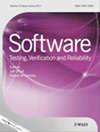Metamorphic relation prioritization for effective regression testing
IF 1.2
4区 计算机科学
Q3 COMPUTER SCIENCE, SOFTWARE ENGINEERING
引用次数: 5
Abstract
Metamorphic testing (MT) is widely used for testing programs that face the oracle problem. It uses a set of metamorphic relations (MRs), which are relations among multiple inputs and their corresponding outputs to determine whether the program under test is faulty. Typically, MRs vary in their ability to detect faults in the program under test, and some MRs tend to detect the same set of faults. In this paper, we propose approaches to prioritize MRs to improve the efficiency and effectiveness of MT for regression testing. We present two MR prioritization approaches: (i) fault‐based and (ii) coverage‐based. To evaluate these MR prioritization approaches, we conduct experiments on three complex open‐source software systems. Our results show that the MR prioritization approaches developed by us significantly outperform the current practice of executing the source and follow‐up test cases of the MRs in an ad‐hoc manner in terms of fault detection effectiveness. Further, fault‐based MR prioritization leads to reducing the number of source and follow‐up test cases that needs to be executed as well as reducing the average time taken to detect a fault, which would result in saving time and cost during the testing process.

有效回归测试的变质关系优先级
变形测试(MT)广泛用于测试面临oracle问题的程序。它使用一组变质关系(MRs)来确定被测程序是否存在故障,这些变质关系是多个输入与其对应的输出之间的关系。通常,MRs检测被测程序中的故障的能力各不相同,有些MRs倾向于检测同一组故障。在本文中,我们提出了对MRs进行优先排序的方法,以提高机器翻译在回归测试中的效率和有效性。我们提出了两种MR优先排序方法:(i)基于故障和(ii)基于覆盖。为了评估这些MR优先级方法,我们在三个复杂的开源软件系统上进行了实验。我们的研究结果表明,我们开发的MR优先级方法在故障检测效率方面明显优于当前以临时方式执行MR源和后续测试用例的实践。此外,基于故障的MR优先级导致减少需要执行的源和后续测试用例的数量,以及减少检测故障所花费的平均时间,这将节省测试过程中的时间和成本。
本文章由计算机程序翻译,如有差异,请以英文原文为准。
求助全文
约1分钟内获得全文
求助全文
来源期刊

Software Testing Verification & Reliability
工程技术-计算机:软件工程
CiteScore
3.70
自引率
0.00%
发文量
34
审稿时长
>12 weeks
期刊介绍:
The journal is the premier outlet for research results on the subjects of testing, verification and reliability. Readers will find useful research on issues pertaining to building better software and evaluating it.
The journal is unique in its emphasis on theoretical foundations and applications to real-world software development. The balance of theory, empirical work, and practical applications provide readers with better techniques for testing, verifying and improving the reliability of software.
The journal targets researchers, practitioners, educators and students that have a vested interest in results generated by high-quality testing, verification and reliability modeling and evaluation of software. Topics of special interest include, but are not limited to:
-New criteria for software testing and verification
-Application of existing software testing and verification techniques to new types of software, including web applications, web services, embedded software, aspect-oriented software, and software architectures
-Model based testing
-Formal verification techniques such as model-checking
-Comparison of testing and verification techniques
-Measurement of and metrics for testing, verification and reliability
-Industrial experience with cutting edge techniques
-Descriptions and evaluations of commercial and open-source software testing tools
-Reliability modeling, measurement and application
-Testing and verification of software security
-Automated test data generation
-Process issues and methods
-Non-functional testing
 求助内容:
求助内容: 应助结果提醒方式:
应助结果提醒方式:


